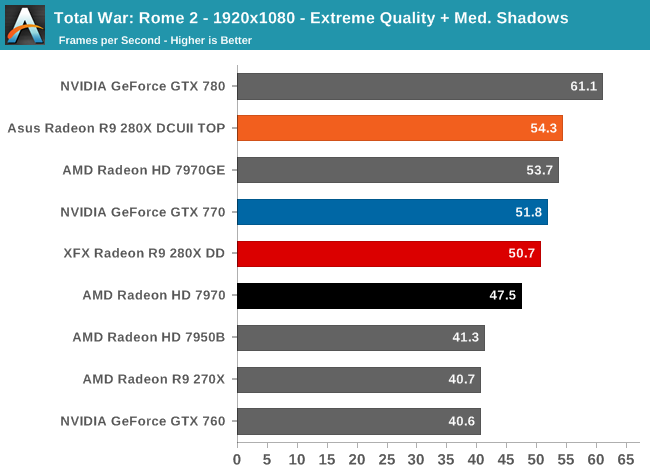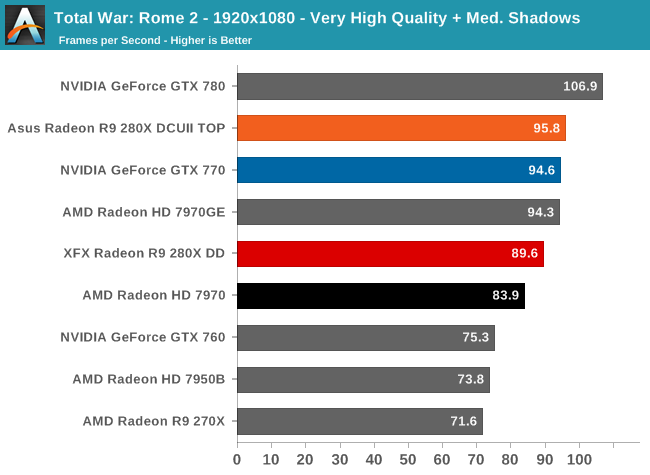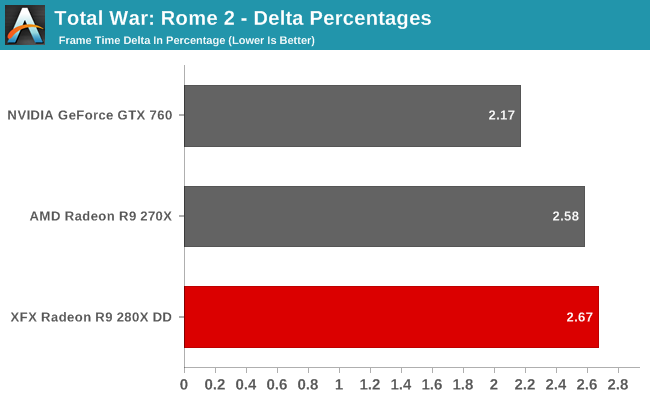The Radeon R9 280X Review: Feat. Asus & XFX - Meet The Radeon 200 Series
by Ryan Smith on October 8, 2013 12:01 AM ESTTotal War: Rome 2
The second strategy game in our benchmark suite, Total War: Rome 2 is the latest game in the Total War franchise. Total War games have traditionally been a mix of CPU and GPU bottlenecks, so it takes a good system on both ends of the equation to do well here. In this case the game comes with a built-in benchmark that plays out over a forested area with a large number of units, definitely stressing the GPU in particular.
For this game in particular we’ve also gone and turned down the shadows to medium. Rome’s shadows are extremely CPU intensive (as opposed to GPU intensive), so this keeps us from CPU bottlenecking nearly as easily.



With Rome 2 AMD and NVIDIA once again flip places, with 280X besting even the GTX 770 by a few percent. All of these enthusiast/high-end cards are just fast enough to keep Rome playable in this situation, with average framerates hovering just a bit over 30fps.

RTS games can be a mixed bag for frametimes as we’ve seen in the past, but Rome presents no such problem. Everyone stays below 3% here.










151 Comments
View All Comments
Drumsticks - Tuesday, October 8, 2013 - link
I'm glad you managed to screw up and then point out every single one of your perceived faults with Anandtech and blame it all on them. That was impressive.By the way, you could have read even the title.
rtsurfer - Tuesday, October 8, 2013 - link
+1Perfectly summarized.
jasonelmore - Wednesday, October 9, 2013 - link
the title doesnt scream rebadge, and typically flagships are launched first, then the sister cards a few weeks later.Etern205 - Monday, October 14, 2013 - link
R8-280x is a rebadged HD7970GE, if they're based on the new architecture like the R9-290x then we won't be reading reviews on it until AMD lifts the NDA.rezztd - Tuesday, October 8, 2013 - link
Why can't they just use simple naming schemes? I've found AMD's names confusing and generally harder to remember than those from NVIDIA.piroroadkill - Tuesday, October 8, 2013 - link
Huh, for a long time I thought AMD's names were logical and ultra-simple, and it was NVIDIA who had the silly names with all their extra letters on the end.However, now the tables are clearly turning, and AMD's naming is terrible.
HisDivineOrder - Wednesday, October 9, 2013 - link
I find the RX 2xx/2xxX naming scheme to be really horrible imo. I have a feeling they did the shift as much to confuse and misdirect away from the fact they did a refresh as to begin a new naming policy because it doesn't really help the consumer.alwayssts - Tuesday, October 8, 2013 - link
I'm just waiting for the XFX info/overclocking page to load...I think if they made their 280x similar to their 37th (only slight hyperbole) revision of the original 7970, that could be a rad product. The current version is 9.3 inches (for tiny cases/htpcs) but purposely very limited in overclocking capabilities...it also sells for around $300 +- $20. If they took that design and were allowed an upped/unlocked voltage/clock spec (with perhaps voltage tuning), that could be a sweet (and tiny) 1080p gaming part compared to anything else that size/price.
Slomo4shO - Tuesday, October 8, 2013 - link
And I was looking forward to determining the overclock potential of this card...zeock9 - Tuesday, October 8, 2013 - link
So there hardly isn't a performance gain over the 7970GE, perhaps less than 5% if that,and they didn't even bother to include the new TrueAudio or Never Settle bundle.
What's the effing point of this 'new' card when 7970GE can already be had for the same price?
Shame on you AMD.